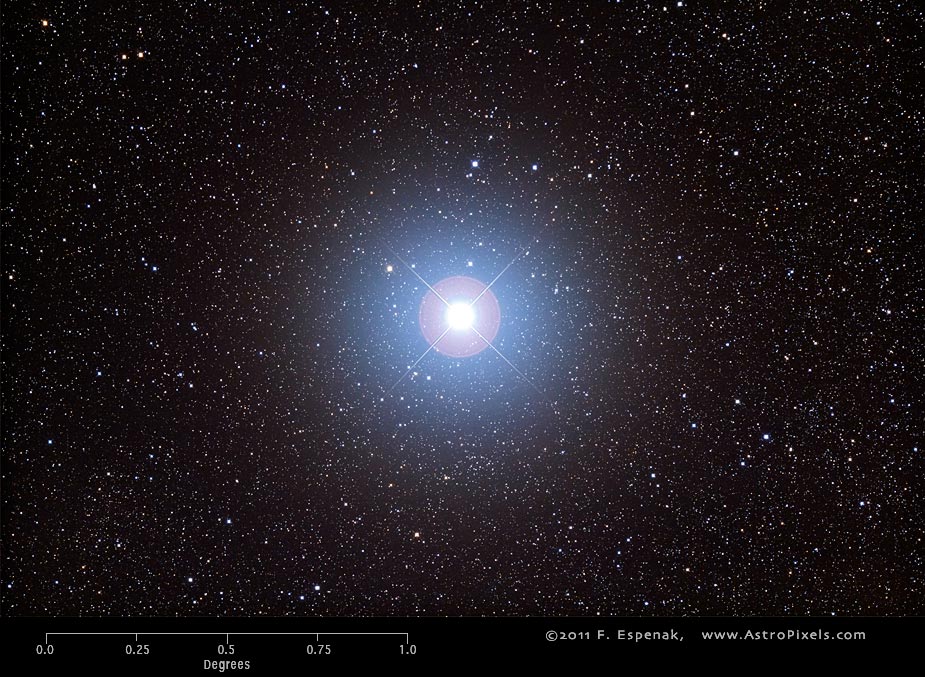Capella
Capella or Alpha Aurigae (Alp Aur) is the brightest naked eye star in the constellation Auriga. With an apparent magnitude of 0.08v, Capella is the 6th brightest star in the entire sky (see: 50 Brightest Stars ). Its absolute magnitude is -0.48 and its distance is 42.2 light years.The Equinox J2000 equatorial coordinates are RA = 05h 16m 41.4s, Dec = +45° 59' 53".
Capella has a spectral type of G5III, a surface temperature of 4940° Kelvin and a luminosity 79 times the Sun. It has a mass of 2.69 solar masses and a diameter 12 times the Sun.
The image above shows the uncropped view of Capella (North is up) through the Takahashi E-180 Astrograph.
Although it appears to be a single star to the naked eye, Capella is actually a star system of four stars in two binary pairs. The first pair consists of two bright, large type-G giant stars, both with a radius around 10 times the Sun's, in close orbit around each other. These two stars are thought to be cooling and expanding on their way to becoming red giants.
The first, primary, star has an surface temperature of approximately 4900 K, a radius of 12 solar radii, a mass of 2.7 solar masses, and a luminosity 79 times that of the Sun. The other, secondary, star has a surface temperature of approximately 5700 K, a radius of 9 solar radii, a mass of 2.6 solar masses, and a luminosity 78 times that of the Sun. Although the primary is the brighter star when considering radiation at all wavelengths, it is the fainter when observed in visible light, with an apparent visual magnitude of approximately 0.91, compared to the secondary's apparent visual magnitude of 0.76
The second binary pair consists of two faint, small and relatively cool red dwarfs. The pair orbit each other at a distance of around 10,000 astronomical units (100 million km) and an orbital period of approximately 104 days. The stars were probably of spectral class A during their main-sequence lifetime, similar to Vega; they are now expanding, cooling, and brightening to become red giants, a process that will take a few million years. It is thought that the more massive star of the pair has begun fusing helium to carbon and oxygen at its center, a process that has not yet begun for the less massive star
The description above is based on the Capella entry in Wikipedia.For more information about Capella, see Stars (Jim Kaler).
Technical Details
- Object: Capella
- Other Names: Alpha Aurigae, HR1708, HD34029, HIP24608
- Object Type: bright star
- Object Data: Apparent Magnitude = 0.08v, Absolute Magnitude = -0.48, distance = 42.2 light years
- Object Position (Equinox J2000): RA = 05h 16m 41.4s, Dec = +45° 59' 53", Constellation = Auriga
- Date/Time: 2011 Apr 05 at 03:47:09 UTC
- Location: Bifrost Astronomical Observatory, Portal, AZ
- Mount: Astro-Physics 1200GTO
- Telescope: Takahashi Epsilon 180 Hyperbolic Astrograph
- Camera: Canon EOS 550D (Rebel T2i) (modified with a Baader UV/IR filter)
- Field of View: 1.70° x 2.56° at 1.7 arc-sec/pixel (web version: 10.0 arc-sec/pixel)
- Exposure: 2 x 300s, f/2.8, ISO 800
- File Name: Capella-01w.jpg
- Processing (Adobe Camera Raw): Graduated Filter, Vignetting Correction, Noise Reduction, White Balance, Curves
- Processing (Photoshop CS5): Average Images, Curves, Noise Reduction
- Original Image Size: 3454 × 5179 pixels (17.9 MP); 11.5" x 17.3" @ 300 dpi
- Rights: Copyright 2011 by Fred Espenak. All Rights Reserved. See: Image Licensing.
